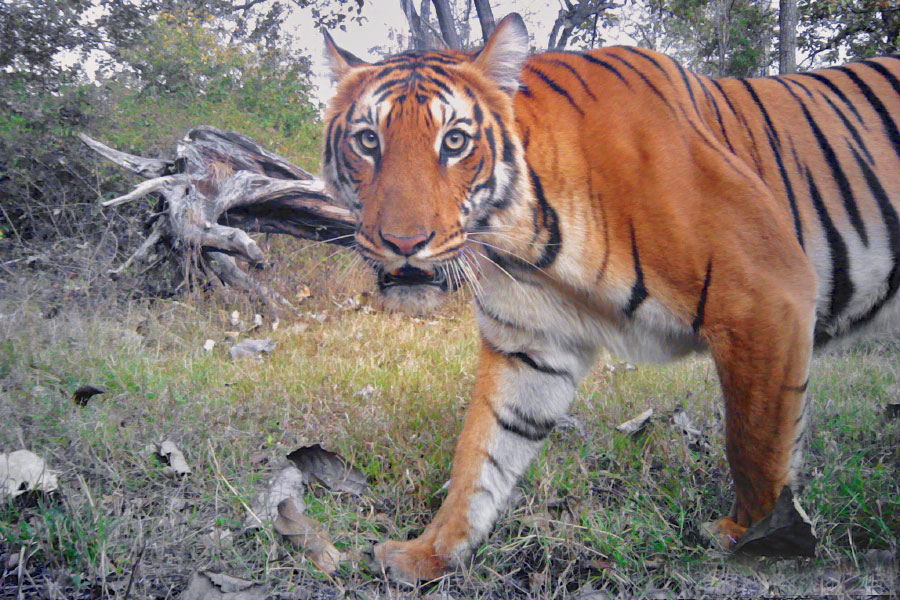- New Book Provides Proven Methods for Monitoring Tiger and Prey Populations
- The earth is currently home to less than 4000 wild tigers
(NEW YORK- December 12, 2017) A new book co-edited by tiger biologist Dr. Ullas Karanth of (WCS) Wildlife Conservation Society and Dr. James Nichols, an Emeritus statistical ecologist from the United States Geological Survey (USGS), provides an authoritative text on monitoring tigers, their prey, and many other similarly endangered species.
The volume is co-authored by 32 authors, from several leading research and conservation organizations, representing a range of technical expertise from tiger biology to mathematical statistics and modeling. The text provides detailed answers to critical questions in population assessment, such as why, what and how to monitor animal populations, and offers hope that such rigorous audits will greatly help in recovering wild tigers.
“Methods for Monitoring Tiger and Prey Populations,” published by Springer, is a culmination of Karanth and Nichols’ decades of research partnership. In it, they have collaborated with 30 other scientists to produce in-depth treaties on advanced scientific methods to accurately track tiger and prey population dynamics. Additional methods demonstrate how multiple connected populations and their distributions can be monitored.
“This work is a distillation of 40 years of science dedicated to the single aim of more effectively conserving wild tigers,” said WCS Director of Global Conservation Dr. John Robinson. As such, it is a foundational text for anyone committed to recovering the world’s largest cat.
” The earth is currently thought to be home to less than 4,000 wild tigers, 96,000 fewer than suggested to have roamed the planet at the beginning of the 20th century. Their survival depends upon the ability of scientists to properly monitor effectiveness of conservation efforts and accurately answer questions such as: Are tiger numbers increasing or decreasing? How are tigers distributed in the wild? What is the status of tiger habitat?
Because tigers are popular icons, the last 50 years have seen vast resources invested by tiger range countries and the global conservation community to save them. However, the status of the big cat remains precarious and its population status is uncertain across much of its range.
Karanth, a conservation biologist and one of the world’s leading authorities on tigers, believes that reliable audits of tiger conservation are essential, and cannot be arrived at by simply throwing money at the situation. He and other co-authors argue that many current, expensive tiger monitoring programs lack the necessary rigor to generate reliable results in spite of massive investments made.
As a world-renowned pioneer in developing and evaluating the efficacy of tiger counting methods, Karanth is in a unique position to make that call. Among his many accomplishments are his critiques that led to the abandonment by the Indian Government of “pugmark tiger census” and its replacement with camera trap sampling developed by him and Nichols that can estimate tiger numbers from photos using their unique stripe patterns. Their collaboration, involving innovative capture-recapture statistical models, has been widely adopted by researchers to estimate population parameters not only for wild tigers but many naturally marked animals.
“Over the years, we’ve successfully adapted our monitoring approaches with the introduction of new tools and techniques, but studying wild populations of tigers and prey species remains challenging,” said Robert Dorazio, a statistician with the USGS Wetland and Aquatic Research Center and one of the book’s co-authors. “We really wanted to make sure the statistical methods presented in this book were state-of-the-art and were capable of extracting as much useful information as possible from the available data.”
Contributing to the text are scientists with expertise in a range of necessary disciplines: biology and ecology of tigers; prey and habitats; advanced statistical theory and practice; computation and programming; practical field-sampling methods that employ technologies as varied as camera traps, genetic analyses and geographic information systems.
Without dependable answers, conservationists and scientists are at a disadvantage in finding and implementing conservation solutions that will safeguard tigers. Thorough monitoring of surviving wild tiger populations continues to be essential for both understanding and recovering wild tigers. The new book details how to do it right.
The book discusses cutting edge methodologies of sampling, modeling, estimation and adaptive management of animal populations using cutting-edge tools such as camera-traps, genetic identification and Geographic Information Systems (GIS) using a modern statistical approach.
“I believe our coauthors in this volume are among the best in business as far as monitoring tigers and other threatened species and as a result this volume represents the state of the art on this topic,” said Ullas Karanth. ”Conservationists should not be satisfied with substandard methods, given how much money and passion they are investing on recovering wild tigers across species range.”


 CI is a non-profit, non-commercial portal that aims to facilitate wildlife and nature conservation by providing reliable information and the tools needed to campaign effectively.
CI is a non-profit, non-commercial portal that aims to facilitate wildlife and nature conservation by providing reliable information and the tools needed to campaign effectively.